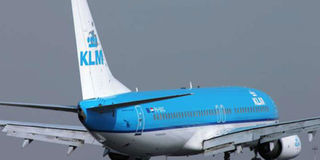Genesis of KQ woes and cause of plane crash

A KLM Boeing 737-800 passenger airliner. Both KLM and KQ agreed to offer competitive fares reflecting their connecting services. FILE PHOTO | NATION MEDIA GROUP
What you need to know:
- Mr Ayah also wondered why the draft memorandum of understanding and articles of association and the shareholders agreement had failed to reflect the Cabinet decision.
- When the Moi Cabinet picked KLM over other applicants seeking to partner with KQ, the decision was based on the fact that the Dutch airline had not demanded veto powers.
When Ndolo Ayah took over as minister for Transport and Communication during the Moi administration, the first thing he did was to familiarise himself with the Kenya Airways privatisation agreement with KLM.
What he found was scandalous, and he said as much.
In a secret letter dated March 15, 1996, which the minister wrote to then Attorney-General Amos Wako, he wondered how KLM directors on the Kenya Airways board were given veto powers over certain key resolutions of the board.
This, he said, went contrary to a Cabinet decision that had ruled out the granting of such veto powers.
Mr Ayah also wondered why the draft memorandum of understanding and articles of association and the shareholders agreement had failed to reflect the Cabinet decision.
Twenty years later, that agreement is now part of the problems facing KQ, as the airline is popularly known by its international code. The airlines’ senior managers and employees have expressed frustration that they have never seen the pact.
Attempts by a Senate committee investigating KLM-KQ relations to lay hands on the document did not get far either.
“When we summoned the KQ leadership to Parliament to answer these questions they were dodgy. We summoned the KLM officials and they were dodgy too. As we found later, the marriage between KLM and KQ is the source of the problem,” said Kisumu Senator Anyang’ Nyong’o, who chaired the investigations.
When the Moi Cabinet picked KLM over other applicants seeking to partner with KQ, the decision was based on the fact that the Dutch airline had not demanded veto powers.
“The Cabinet selected KLM as opposed to South African Airways (SAA) specifically because, among other things, SAA demanded to have such veto powers while KLM did not,” said Mr Ayah in the letter that he also copied to then Finance minister Musalia Mudavadi and Fares Kuindwa, the permanent secretary in the Office of the President and secretary to the Cabinet.
STAFF RIVALRY
Mr Ayah wanted the issues resolved before the final public flotation of the government’s 51 per cent shareholding at the Nairobi Stock Exchange.
“I propose as a matter of urgency that legal officers from your office, and possibly together with KLM lawyers meet and amend both the shareholders agreement and the draft memorandum and articles of association of Kenya Airways, so that the Kenya Government position as approved by the Cabinet is accurately reflected in these two very important documents,” said the letter.
What Mr Ayah did not know was that by that time, an agreement had already been signed between Treasury permanent secretary Benjamin Kipkulei and KLM giving them the veto powers.
This still exists in article 115 of the articles of association of Kenya Airways Ltd.
As a result, KQ was left with an agreement that gives its partner much more say, according to insiders.
However, CEO Mbuvi Ngunze told the Nation that it is not necessarily true that KLM has the upper hand.
“The decision-making inside this boardroom is consultative. Corporate governance has changed over the years and the existence of such a clause does not worry me,” he said.
He, however, admitted that the partnership with KLM has had a share of its problems.
“We don’t have a perfect marriage … but we have dedicated more staff to the joint venture and are educating them on how it is supposed to operate,” he said.
The frosty relationship between KQ staff and KLM did not start recently. In 1996, the joint venture got into problems after KLM started flying in its engineers and leasing an Airbus at $97,000 per month while KQ’s Airbuses remained grounded.
The engineers were then being paid $14,700 for work that could have been done by Kenyans. Over the years, such rows became routine.
While the CEO at the time, Brian Davis, acknowledged that the airline was facing “misfortunes”, he blamed the problems on staff reluctance to appreciate “sound business decisions”.
Mr Davies also brought in “experts” to update the airline’s operations manual at a cost of $51,000.
That was an illegality since the Civil Aviation Act (CAP 394) only gave such a task to the chief pilot, who was empowered to take it to the Directorate of Civil Aviation for approval.
AVOIDABLE CRASH
The chief pilot was Joseph Mutungi, one of Kenya’s pioneer African pilots.
KLM also started closing down KQ booking offices abroad and recalling the Kenyan managers who were manning profitable offices such as Zurich, Frankfurt, Tokyo, Hong Kong, Los Angeles and New York City.
Although the New York office was closed down, it had in the 1994-95 financial year managed to make direct sales amounting to $3.9 million compared with overhead costs of $420,000.
The office was projected to make $4.1 million during the 1996/97 financial year, against overhead costs of $520,000.
Back in Nairobi, managers appointed by KLM started ignoring locals, even on matters as mundane as change of uniform.
KQ then started having troubles with its Airbus planes, which were experiencing fuel leaks.
One of them had to make an emergency landing in Luxor, Egypt, and Mr Davis had to fly in engineers from Airbus Industries after locals spent two days trying to mend the problem but were unsuccessful.
This Airbus A310, purchased in 1986, finally crashed in January 2000 after taking off from Abidjan, Ivory Coast, killing 169 passengers and crew.




